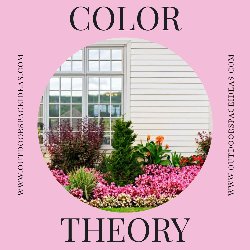Bringing Your Garden to Life with Color Design Techniques

Learn how to use basic color theory in landscape and garden design to create a beautiful and harmonious outdoor space.
From understanding the color wheel and color psychology to choosing the right color scheme and using techniques like color blocking and contrast, this post covers everything you need to know to make your garden a stunning work of art.
Introduction
Color is an important element in landscape and garden design, as it can set the mood, create visual interest, and even affect our emotions.
Understanding basic color theory can help you make informed choices about the colors you use in your outdoor space. We explore the fundamentals of color theory for landscape design, including the color wheel and its components, color psychology and its applications, and different types of color schemes.
We’ll also cover techniques for incorporating color into your garden design, such as using color as a focal point, color blocking, contrast and color placement, and creating balance and harmony with color.
Hopefully by the end of this post, you’ll have the knowledge and tools you need to use color effectively in your landscape and garden design.
The Fundamentals of Color Theory for Landscape Design
Before we delve into the specifics of using color in landscape design, it’s important to understand the basics of color theory.
The color wheel is a useful tool that can help us identify the different colors and their relationships to each other.
The Color Wheel and Its Components
The color wheel is a circular diagram that represents the colors of the spectrum.
- The three primary colors are red, yellow, and blue.
- Secondary colors are made by mixing two primary colors. These include orange, green, and purple.
- Tertiary colors are made by mixing one primary color with one secondary color.
Warm and Cool Colors
Colors can be categorized into warm and cool colors.
- Warm colors include red, orange, and yellow, while cool colors include blue, green, and purple.
- Warm colors create a sense of energy and vibrancy, while cool colors create a feeling of calmness and relaxation.
Analogous, Complementary, and Triadic Color Schemes
Different color schemes can be used in landscape design to create specific moods and effects.
- Analogous colors are those that are next to each other on the color wheel. These colors create a harmonious and calming effect.
- Complementary colors are those that are opposite each other on the color wheel. These colors create a high-contrast and dramatic effect.
- Triadic color schemes are those that use three colors that are evenly spaced on the color wheel. These colors create a sense of balance and harmony.
Color Psychology and its Applications
Colors have been shown to have a psychological effect on people.
Color associations and meanings vary across cultures, but there are some general associations that can be applied to landscape design. For example, green is often associated with nature and growth, while blue is associated with calmness and tranquility.
By understanding color psychology, you can use color to create specific moods and emotions in your outdoor space.
Designing with Color for Unique Environments
When choosing a color scheme for your garden design, it’s important to consider the environment in which the garden is located.
Different colors can have different effects depending on the location and climate. For example, bright colors may be appropriate for a garden in a sunny and warm location, while cooler colors may be more appropriate for a garden in a shaded and cooler location.
Choosing the Right Color Scheme for Your Garden Design
There are several factors to consider when choosing a color scheme for your garden design, including location and climate, plant and flower selection, and size and shape of the garden. It’s important to choose a color scheme that complements the existing features of the garden and creates a balanced effect.
Popular Color Schemes for Garden Design
There are several popular color schemes that can be used in garden design, including:
- Monochromatic: This color scheme uses different shades of the same color to create a calming and harmonious effect.
- Complementary: This color scheme uses opposite colors on the color wheel to create a high-contrast and dramatic effect.
- Triadic: This color scheme uses three colors that are evenly spaced on the color wheel to create a sense of balance and harmony.
Techniques for Incorporating Color in Landscape Design
There are several techniques for incorporating color in landscape design, including:
- Using Color as a Focal Point: By using bright colors or creating color contrasts, you can draw attention to specific areas of your outdoor space.
- Color Blocking for Visual Impact:Color blocking involves grouping plants or flowers of the same color together to create a bold and striking effect.
- Contrast and Color Placement: By placing contrasting colors next to each other, you can create a dynamic and visually interesting effect.
- Creating Balance and Harmony with Color: By using different color schemes and balancing warm and cool colors, you can create a harmonious effect in your garden design.
- Using Neutral Colors as a Background: Neutral colors, such as white, gray, and beige, can be used as a background to help showcase the colors of your plants and flowers.
- Using Color Gradients: Gradually changing the colors of your plants or flowers from one color to another can create a subtle and gradual transition of color throughout your garden.
Conclusion
Transform Your Garden with Basic Color Theory
Using basic color theory in landscape and garden design can help you create a beautiful and harmonious outdoor space.
By understanding the color wheel, color psychology, and different color schemes, you can choose the right colors to create the mood and effect you desire.
With careful planning and consideration, you can use color to transform your garden into a stunning work of art.

Ian Sparrow
Hi l am a part time blogger, affiliate marketer and founder of Bestdesigneye.com. I post content on niche website design, WordPress and SEO.
